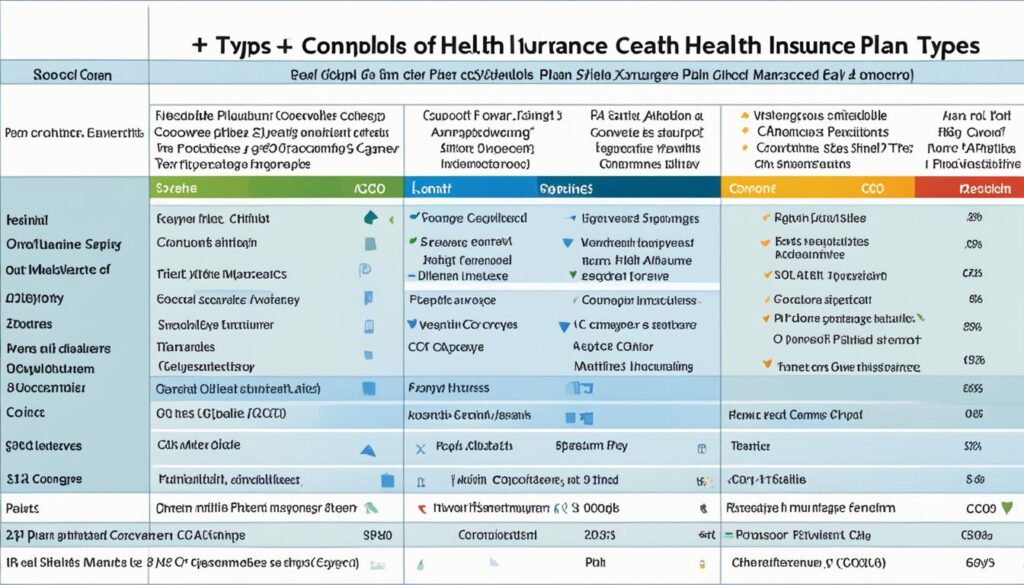Navigating the complex world of health insurance plans can be a daunting task, especially when it comes to ensuring you and your family have the right coverage. Whether you’re exploring individual and family plans, Medicare, or group health insurance options, the choices can be overwhelming. This comprehensive guide is designed to empower you to make informed decisions about your health plan and find the coverage that best fits your unique needs.
The article provides a detailed overview of the various insurance company offerings, from employer-sponsored plans to those available through state and federal marketplaces, as well as private insurance exchanges. You’ll learn how to navigate the open enrollment process, understand the importance of preventive care, and evaluate the potential benefits of virtual care and wellness programs.
Delving deeper, we’ll explore the different types of health plans available, including HMOs, PPOs, EPOs, and POS plans, highlighting the key features, provider network considerations, and cost structures of each. By understanding these plan options, you’ll be better equipped to select the right deductible, coinsurance, and copay levels to meet your health coverage needs and budget.
Additionally, this guide will walk you through the process of analyzing out-of-pocket costs, evaluating plan benefits, and assessing your personal and family’s healthcare requirements. Whether you’re enrolling in Medicaid, exploring Medicare coverage, or searching for an affordable health insurance plan, you’ll find the information and resources you need to make the best decision for your stage of life.
Key Takeaways
- Understand the different health insurance marketplaces, including employer-sponsored plans, state/federal exchanges, and private exchanges.
- Familiarize yourself with the various types of health insurance plans, such as HMOs, PPOs, EPOs, and POS plans, and their key features.
- Evaluate the provider networks of health plans, considering in-network vs. out-of-network costs and preferred providers.
- Analyze out-of-pocket expenses, including deductibles, copays, and coinsurance, to find the right balance between premiums and coverage levels.
- Explore the scope of covered services, prescription drug benefits, and other plan features to ensure your healthcare needs are met.
Understanding Health Insurance Marketplaces
When it comes to obtaining health insurance coverage, most people rely on employer-sponsored plans. However, for those who don’t have access to employer-provided health insurance plans, there are several other options available, including state and federal marketplaces, as well as private insurance exchanges.
Employer-Sponsored Health Insurance
Employer-sponsored health insurance is often the most common and convenient option for many individuals and families. Employers may offer a range of plan options, allowing employees to choose the coverage that best fits their needs and budget. These plans typically provide comprehensive health coverage, including preventive care, virtual care, and wellness benefits.
State and Federal Marketplaces
For those who don’t have access to employer-sponsored health insurance, state and federal marketplaces, also known as the Affordable Care Act (ACA) exchanges, offer an alternative way to enroll in individual and family health plans. These marketplaces allow individuals to compare plan options, plan details, and plan costs, and may provide access to premium tax credits and other financial assistance to help make health coverage more affordable.
Private Insurance Exchanges
In addition to government-run marketplaces, there are also private insurance exchanges that offer individual and family health plans. These exchanges may provide a wider range of plan options, but do not offer the same premium tax credits and financial assistance available through the state and federal marketplaces. It’s important for consumers to carefully compare the plan details and costs across all available health insurance options to find the best fit for their individual or family needs.
Comparing Health Insurance Plan Types

When exploring health insurance plans, it’s crucial to understand the different plan types available, as each offers its own unique set of features and tradeoffs. Let’s delve into the key characteristics of the most common health plan options, including HMOs, PPOs, EPOs, and POS plans.
HMO (Health Maintenance Organization)
HMOs typically provide the most cost-effective coverage, but with the trade-off of a more limited provider network. HMO members must select a primary care physician (PCP) who coordinates their care and provides referrals to see specialists. Out-of-network care is generally not covered, except in emergencies. This plan structure often results in lower deductibles, copays, and coinsurance rates for in-network services.
PPO (Preferred Provider Organization)
PPOs offer more flexibility in choosing healthcare providers, as members can see both in-network and out-of-network doctors without a referral. However, this freedom comes with higher out-of-pocket costs for out-of-network care. PPOs typically have higher premiums but lower deductibles and copays for in-network services when compared to HMOs.
EPO (Exclusive Provider Organization)
EPOs are a hybrid of HMOs and PPOs, providing a balance between the cost-effectiveness of an HMO and the provider flexibility of a PPO. EPO members must stay within the plan’s network to receive coverage, but they do not need referrals to see specialists. Out-of-network care is generally not covered, except in emergencies.
POS (Point of Service Plan)
POS plans combine features of both HMOs and PPOs. Members have the option to use in-network providers, which results in lower out-of-pocket costs, or to see out-of-network providers, which incurs higher costs. POS plans typically require a referral from a PCP to see specialists, similar to an HMO structure.
By understanding the key differences between these plan types, consumers can make more informed decisions about which health insurance plan best meets their healthcare needs and financial situation.
| Plan Type | Provider Network | Referrals Needed | Out-of-Network Coverage | Typical Costs |
|---|---|---|---|---|
| HMO | Restricted to in-network providers | Yes, from PCP | Limited, except in emergencies | Lower premiums, deductibles, and copays |
| PPO | Broader network, can use out-of-network providers | No | Coverage available, but higher out-of-pocket costs | Higher premiums, lower deductibles and copays for in-network care |
| EPO | Restricted to in-network providers | No | Limited, except in emergencies | Moderate premiums, deductibles, and copays |
| POS | Can use both in-network and out-of-network providers | Yes, from PCP for out-of-network care | Coverage available, but higher out-of-pocket costs for out-of-network | Moderate premiums, deductibles, and copays |
Evaluating Plan Networks

When selecting a health insurance plan, it’s crucial to carefully evaluate the provider network. The network of healthcare providers, facilities, and specialists can have a significant impact on your out-of-pocket costs and access to care. Understanding the differences between in-network and out-of-network providers, as well as a plan’s preferred doctors and facilities, can help you make an informed decision that aligns with your healthcare needs and budget.
In-Network vs. Out-of-Network Providers
In-network providers are healthcare professionals and facilities that have contracted with your insurance company to provide services at pre-negotiated rates. Using in-network providers can significantly reduce your out-of-pocket costs, as you’ll typically only be responsible for a copay or coinsurance payment. In contrast, out-of-network providers have not agreed to the insurance company’s contracted rates, so you’ll likely pay more for their services, including higher deductibles and coinsurance rates.
Preferred Doctors and Facilities
Many health insurance plans have a network of “preferred” or “in-network” doctors, hospitals, and other healthcare facilities. These providers may offer additional benefits, such as lower out-of-pocket costs or enhanced coverage, compared to other in-network providers. Reviewing a plan’s list of preferred providers can help you ensure you have access to the healthcare professionals and facilities you prefer while minimizing your financial liability.
Network Size and Location
The size and geographic coverage of a health plan’s provider network can also be important considerations. A larger network may offer more flexibility in choosing healthcare providers, while a smaller network may result in lower premiums but fewer options. Additionally, the plan’s coverage area can impact your ability to access in-network care, especially if you travel or have family members living in different regions.
By carefully evaluating a health insurance plan’s provider network, you can ensure you have access to the healthcare services you need while minimizing your out-of-pocket costs. This understanding of network dynamics is a crucial step in selecting the right health insurance plan for your individual or family’s needs.
Health Insurance Plans

When it comes to health insurance plans, consumers have a wide range of options to choose from, including those offered through employers, government-run marketplaces, and private insurers. Each plan type has its own unique features and considerations that should be carefully evaluated to ensure you select the coverage that best meets your individual or family’s healthcare needs and financial situation.
Employer-sponsored health insurance plans are often a popular choice, as they may provide more comprehensive benefits and subsidized premiums. State and federal marketplaces, established under the Affordable Care Act, offer a range of individual and family health plans, with the potential for premium tax credits to help make coverage more affordable. Private insurance exchanges also provide a variety of plan options, though they may not offer the same financial assistance as government-run marketplaces.
Regardless of the type of plan you choose, it’s essential to thoroughly research and compare the details to understand the scope of covered services, network of providers, cost-sharing arrangements (such as deductibles, copays, and coinsurance), and any exclusions or limitations that may apply. Taking the time to evaluate all of these factors will help you select the most appropriate and cost-effective health insurance coverage for your individual or family’s needs.
Analyzing Out-of-Pocket Costs

When selecting a health insurance plan, it’s crucial to carefully evaluate the out-of-pocket costs associated with your coverage. These include deductibles, copays, and coinsurance, all of which can significantly impact your overall healthcare expenses. Understanding how these cost-sharing mechanisms work can help you make an informed decision and find the health plan that provides the best value for your individual or family’s needs.
Deductibles, Copays, and Coinsurance
The deductible is the amount you must pay out of pocket before your health insurance coverage kicks in. Copays are fixed dollar amounts you pay each time you receive a covered service, such as a doctor’s visit or prescription. Coinsurance, on the other hand, is the percentage of the cost you must pay for covered services after you’ve met your deductible. Understanding these cost-sharing features and how they apply to the specific plan options you’re considering is crucial in determining your overall out-of-pocket expenses.
Out-of-Pocket Maximums
Most health insurance plans also include an out-of-pocket maximum, which is the maximum amount you’ll have to pay for covered services in a given year. Once you reach this limit, the insurance company will cover 100% of your remaining covered healthcare costs. Knowing your plan’s out-of-pocket maximum can help you budget and plan for your expected healthcare expenses throughout the year.
Balancing Premiums and Coverage Levels
When evaluating health insurance plan options, it’s important to consider the tradeoffs between higher premiums with lower out-of-pocket costs versus lower premiums with higher out-of-pocket costs. Individuals and families with frequent medical needs may benefit from a plan with higher premiums but lower deductibles, copays, and coinsurance rates. Conversely, those with fewer healthcare requirements may find that a plan with a lower premium but higher out-of-pocket costs is the better fit for their budget and usage patterns. Carefully weighing these factors can help you select the coverage level that provides the right balance of affordability and comprehensive health coverage.
Considering Plan Benefits
When selecting a health insurance plan, it’s essential to carefully review the scope of covered services. This includes understanding the plan’s provisions for routine preventive care, doctor visits, emergency services, hospital stays, and specialty care. Some plans may offer more comprehensive coverage, while others may have more limited benefits, so it’s crucial to align the plan’s offerings with your individual or family’s healthcare needs.
Scope of Covered Services
Depending on the type of health insurance plan, the coverage may vary. For instance, an HMO (Health Maintenance Organization) plan typically has a more restricted network of providers, but it often includes a broader range of preventive care services, such as annual check-ups and screenings. In contrast, a PPO (Preferred Provider Organization) plan may offer more flexibility in choosing healthcare providers, but the coverage for certain services may be more limited.
Prescription Drug Coverage
Another important consideration when evaluating health insurance plans is the level of prescription drug coverage. Plans may differ in the drugs they cover, the copays or coinsurance required, and the availability of generic or preferred brand-name medications. It’s advisable to review the plan’s prescription drug formulary to ensure your necessary medications are included, and to understand the associated out-of-pocket costs.
Get health insurance coverage that suits your needs with Cigna Health and Life Insurance Company, offering a variety of group health insurance plans and affordable health insurance plans tailored to every stage of life. It’s important to note that plans contain exclusions and limitations, so it’s crucial to review your plan documents or contact a Cigna healthcare provider to explore health benefits and compare plans. With different types of health care plans available, including Medicaid plans and plans offered through the Affordable Care Act, Cigna ensures that individuals can get covered regardless of their stage of life. Cigna healthcare products and services are provided exclusively by or through operating subsidiaries of the Cigna Group, such as Cigna Healthcare of North Carolina, Cigna Healthcare of South Carolina, and others. Remember, providers are solely responsible for services provided, and benefits may vary depending on the plan’s network. Utilize dedicated virtual urgent care and national telehealth providers for convenient access to healthcare services, and review plan documents to understand what’s covered and any coinsurance or deductible requirements. With Cigna, you can rest assured that your health insurance needs are in good hands, whether you’re insured by Cigna Health or insured by Cigna Health and Life Insurance Company.
Also Read: Medical Health: Trusted Advice For Optimal Wellness
Conclusion
Selecting the best health insurance plan requires careful consideration of various factors to ensure it meets your individual needs and preferences. It’s essential to evaluate the coverage options available, considering aspects such as premiums, deductibles, and copayments, to find a plan that aligns with your budget and financial situation. Additionally, understanding the specific benefits offered by each plan, including coverage for essential services like preventive care, prescription drugs, and specialist visits, is crucial for ensuring comprehensive healthcare coverage. Furthermore, assessing network providers and facilities included in the plan’s network is vital to ensure access to quality healthcare services and minimize out-of-pocket expenses. Considering factors such as coverage limitations, exclusions, and any restrictions on pre-existing conditions can help avoid unexpected costs and coverage gaps. Lastly, reviewing customer reviews, ratings, and feedback on the plan’s customer service and claims process can provide valuable insights into the overall satisfaction and experience of enrollees. By carefully evaluating these factors and conducting thorough research, individuals can make informed decisions and choose the best health insurance plan that meets their unique healthcare needs and provides peace of mind for the future.
FAQs
Q: How do I choose the best health insurance plan for my needs?
A: When selecting a health insurance plan, consider factors such as your stage of life, the type of coverage you need, whether you have any pre-existing conditions, and your budget. It’s also important to compare plans from different insurance companies to find the one that best meets your needs.
Q: What is the difference between Medicare and individual health plans?
A: Medicare is a federal health insurance program for people over 65 and certain younger individuals with disabilities. Individual health plans are typically purchased by individuals or families from private insurance companies or through the healthcare marketplace.
Q: How can I enroll in a health insurance plan?
A: You can enroll in a health insurance plan during the open enrollment period or if you experience a qualifying life event. You can usually enroll online, over the phone, or in person.
Q: What is virtual care and does my health insurance plan cover it?
A: Virtual care allows you to consult with healthcare providers remotely through phone or video calls. Some health insurance plans cover virtual care services, but it’s important to check with your insurance company for details.
Q: How can I find care with my health insurance plan?
A: Depending on your plan, you may be able to search for in-network healthcare providers online, through a mobile app, or by contacting your insurance company directly. Make sure to understand your plan’s coverage and limitations before seeking care.
Q: What types of health insurance plans are available?
A: Common types of health insurance plans include HMOs, PPOs, EPOs, and high-deductible health plans. Each type of plan has its own features, costs, and network of providers.
Q: What is the significance of having health insurance coverage?
A: Health insurance coverage helps protect you from high medical costs, provides access to preventive care services, and ensures that you can receive medical treatment when needed without facing financial hardship.
Source Links
- https://www.uhc.com/understanding-health-insurance/open-enrollment/understanding-coverage/tips-for-choosing-a-health-insurance-plan
- https://www.healthcare.gov/choose-a-plan/comparing-plans/
- https://www.nerdwallet.com/article/health/choose-health-insurance




